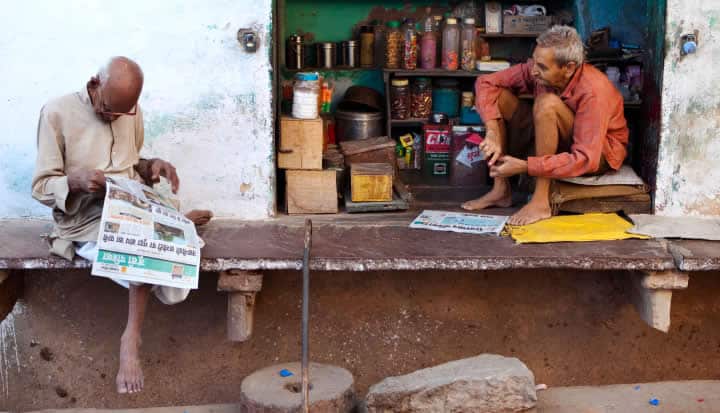What do dairy cooperatives, micro-finance institutions, post offices, mobile phones, boys on bikes and women who walk all have in common?
They are all potential channels to reach consumers at the base of the pyramid (BOP) with products ranging from agro-information to water-filters, including lighting, medicine, stoves and household goods.
The challenge of selling to consumers at the base of the pyramid has not been ‘solved’. It’s an emergent difficult market that requires businesses to junk conventional practice and adapt. Many companies still struggle with pilots that do not scale, or find themselves relying more on mid-pyramid customers than they expected.
But is it on the way to being solved? Maybe, because there are not only a host of useful experiences, but also a good trend of sharing what works.
In a new ‘Inside Inclusive Business’ report from the Business Innovation Facility, we outline three alternative approaches that companies can use to reach BOP consumers: develop your own infrastructure, harness an existing network of another organization with reach, or develop a franchisee network of entrepreneurs. On each of these we can recommend a practical report based on experience of others, to help you develop your approach.
The middle option leads companies into some surprising new partnerships – post offices, dairy cooperatives and the like and is the focus of the new BIF report . Written by Nisha and her colleague Rashi Agrawal, it explores how four BIF-supported businesses in India have tapped into existing networks. This experience generates a six-step process for selecting networks to partner with, and a partnership selection framework.
The right-side option, developing a network of franchisees or village level entrepreneurs is also seen widely as the strategy of choice in the BIF portfolio, and also in the portfolio of Innovations Against Poverty. A good example is Sanergy, whose Fresh Life Operators promote slum toilets, as described in their recent blog on the Practitioner Hub: “The makings of a Sanergy Superstar”. However, we are yet to see many more of these franchisee plans turn into successful reality, perhaps due to some of the challenges well-flagged in the first Inside Inclusive Business report by Nisha: “The ‘last mile’ challenge: The limitations of the village entrepre….
The left-side option is to build your own infrastructure and sales force. An expensive option. Few companies in the BIF portfolio have made this investment, but interestingly investing in your own BOP sales force emerges as a strong recommendation in an excellent new report from Hystra on strategies for marketing innovation products to the BOP. This report is deservedly Editor’s Choice this month on the Practitioner Hub, and provides 10 very sharp lessons from the experience of companies that have achieved substantial sales at the BOP.
In some cases, a hybrid of all three strategies is needed. An example from the BIF portfolio is Oando, a large energy company selling liquified petroleum gas (LPG) stoves to the BOP market in Nigeria. Their existing networks of gas-filling stations are essential, and already have the equipment, skills and standards in place for gas-filling. But to serve BOP customers they need to have distribution points within walking distance from their homes, where empties can be exchanged. So developing a network of entrepreneurs is also part of the strategy. Finally, a major area of BIF input has been to link Oando with other stakeholders who do not sell energy but have reach to BOP consumers in other ways: because they work in local government, environment, or local development. These are new partners for an energy company that previously thought about sales more in terms of metric tonnes of gas, not women empowerment, retarding desert encroachment, or saving the rainforest. The unusual partners do not of course serve as actual distributor or gas re-fillers, but through these channels the stoves get demonstrated, and customers drawn in.
So whichever strategy you choose, there is experience of others to draw upon, but no hard and fast rules as to what works best. The only rule seems to be innovate and adapt to meet the needs, wallets and purchasing patterns of consumers at the BOP.
For further information, please see the links below:
- Practitioner Hub Know-how section on “Last mile distribution to low income consumers”
- Inside Inclusive Business
- Inside Inclusive Business “The ‘last mile’ challenge: The limitations of the village entrepre…
- Editor’s Choice on the Practitioner Hub: “Marketing Innovative Devices for the Base of the Pyramid”, published by Hystra.
This blog is part of an Inclusive Business Insights Series, brought to you in partnership with the Business Innovation Facility and Innovations Against Poverty.
Working closely with companies at the ‘coal-face’ of inclusive business, the Business Innovation Facility and Innovations Against Poverty aim to share lessons learned and insights gained from over 100 projects across the developing world. Each month, this blog series will feature selected articles written by members of the team working on the ground, to highlight the challenges and opportunities of implementing inclusive business and to spark fresh thinking and innovative approaches to leveraging business for development.











3 Responses
“Business Fights Poverty” vs. The challenge of selling to consumers at the #BoP”- Contradictory?
Wow, Nishi, very interesting and well presented!
I’ll share this around.
For those who focus on bringing solar energy to BoP, perhaps these can further help:
– http://www.renewableenergyworld.com/rea/news/article/2011/08/delive…
– http://bennu-solar.com/
Thanks,
Yotam
(http://www.linkedin.com/in/yotamariel)
Thanks for this article. I would propose a third options considering that it is rare that only one company tries to reach the BoP. For solar solutions, for example, all brands and national distributors face the “Last Mile” challenge. If every and single brand invest in one of the three options it might not be cost effective and too costly anyways. What should be proposed is to identify “pre-competition” investment opportunities where several companies accept to invest in. For example, the emergence of village or community entrepreneurs representing potential consumers (and not a specific brand) can be a pre-competition investment. All brands and distributors, and I will add financial institutions that will also benefit from it, can co-invest in micro and small business support that will catalyse the emergence of such village or community entrepreneurs as potential business associates.
What is needed is an “orchestrator” of such collective investment. and here we should avoid going to fast in suggesting NGOs but we should think on a “commercial service” that can do the job of co-designing BDS packages for community entrepreneurs with the brands and banks, co-creating innovative business models and coaching and mentoring such BoP entrepreneurs.
SNV Uganda and OXFAM Novib with the cooperation of Conclusion are supporting such strategy in Uganda.